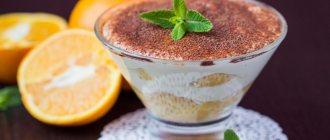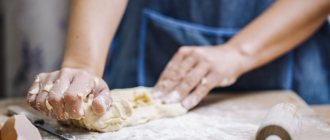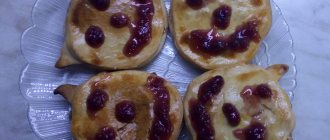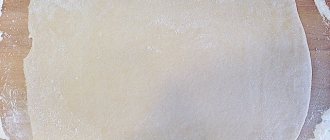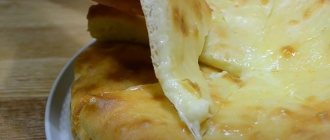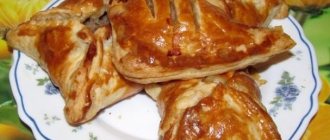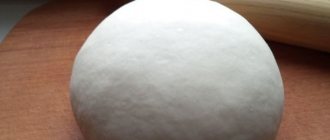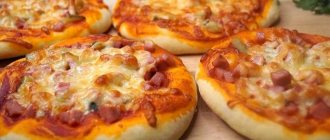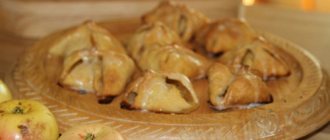Shortcrust pastry products
Shortbread dough is prepared with a large amount of butter (26%) and sugar (18%); The dough turns out very thick and its humidity does not exceed 20%. In such conditions, yeast cannot develop and cannot be used as a leavening agent for this type of dough. The main leavening agent in shortcrust pastry is butter. It makes the dough crumbly: it envelops the flour particles and prevents them from coming together.
Flour for shortcrust pastry is taken with an average amount of gluten (28-36%). If you take flour with a small amount of gluten, the products will turn out too crumbly and will be difficult to mold; if with a large one, then the products will turn out to be tight. To further loosen the dough, chemical leavening agents are added to it - ammonium carbonate and baking soda, which decompose when heated, releasing gases.
A well-kneaded dough should not contain lumps of flour or butter. It should be a homogeneous, dense, plastic oily mass of gray-yellow color. Dough moisture content is 18.5-19.5%.
Shortbread dough
Flour 560, including for dusting 41, butter or margarine 311, sugar 207, essence 2, melange 73, ammonium 0.5, salt 2, soda 0.5. Yield 1000 g.
The refined butter or margarine is placed in a beater; turn it on low and beat the butter until it becomes plastic. After this, add the remaining products (according to the norm), except flour, turn on the machine at high speed and beat the mass for 12-15 minutes, periodically removing the stuck mass from the edges of the machine. Then add flour and switch the machine to low speed so that the flour does not spray out. Knead the dough for 3 minutes.
When mixing the dough for a long time, the gluten swells and the dough loses its plasticity, becomes rubbery and difficult to shape. When baked, products made from such dough acquire a lumpy surface, onto which the fondant and filling lie unevenly. It is difficult to cut layers, there is no friability.
The scheme for preparing the semi-finished sand product is shown in Fig. 23.
When making a small amount of dough manually (up to 5 kg of flour), it is kneaded in a bowl. The butter or margarine is peeled, placed on the table or in a bowl and kneaded until the fat is plastic. Very hard butter or margarine is pre-cut into thick pieces
2 cm, place them on a baking sheet and place in a warm place (25-35°) to soften,
The fat, mashed to a plastic state, is placed in a bowl, the rest of the products are added (according to the norm), except flour, and kneaded with hands or a paddle until a homogeneous mass is formed. If, during kneading, the butter does not combine with the rest of the products for a long time, then add a little flour, and then the rest of the flour.
Large portions of dough (over 5 kg of flour) are prepared manually as follows: flour is sifted onto the table, made in the middle
Rice. 23. Scheme for preparing semi-finished shortcrust pastry
a funnel into which the butter mass is placed and mixed until the mass becomes plastic, then a 2-3 kg piece of dough is torn off, kneaded and placed on a table dusted with flour. The next kneaded pieces are placed on top of each other until all the dough is kneaded.
If the temperature of the dough during kneading does not exceed 20°, then it can be immediately molded into products. Otherwise, to make cutting easier, the dough must be cooled to 15-18°. In this case, it is necessary to avoid overcooling the dough and the formation of hard lumps that are difficult to cut.
Below are shortcomings that may occur during the production of dough and the reasons for their occurrence.
| Flaws | Causes |
| The dough is not plastic, it crumbles when rolled out, and fat comes out of it when baked. | The dough is kneaded with melted or heavily mashed butter or other warm products The dough is warm |
| Baked goods are rough and crumbly | Lots of flour and liquid, little fat. Fat is added to the dough last. |
| The dough is long and shrinks when rolled out. When baking, the products are small in volume and hard. | The dough was kneaded for a long time. The layer was unevenly rolled out. |
| The layers burned in places | The baking tray was not turned in the oven in a timely manner |
| The product is very crumbly | Instead of eggs, only egg yolks or a lot of butter are added |
| Products are rigid, glassy | Instead of eggs, added egg whites or a lot of sugar, not enough butter |
- Shortbread cookies
Flour 522, sugar 209, butter margarine 313, melange 73, salt 0.5, roasted nuts for sprinkling 16, sugar 37. Yield 1000 g (at least 60 pcs.).
Applying a pattern to shortbread dough with a grooved and waffle rolling pin
Roll out the shortbread dough to a thickness of 4 mm. The surface of the formation is smeared with melange, sprinkled with chopped nuts or almonds, and then with sugar. When the melange dries a little, cookies are cut out of the dough layer with a notch or a knife, placed on a dry baking sheet and baked at 230-250°.
Quality requirements: cookies of various shapes, not deformed, edges intact; there should be no traces of unmixed flour or hardening on the break; when pressed, the cookies crumble; humidity 6%
- Cookies Sliced
For the dough: flour 636, sugar 286, table margarine 96, salt 5, ammonium 0.6, soda 4, vanilla powder 2, water 70; for invert syrup: sugar 23, water 10, acetic acid 0.5, vegetable oil for greasing baking sheets 0.2. Yield 1000 g (at least 90 pcs.).
Prepare shortbread dough without eggs, but with invert syrup (recipe 19). The dough is rolled out into a layer 5-6 mm thick and a pattern is applied to it with a waffle rolling pin (Fig. 24), after which it is cut into rectangular cookies.
For quality requirements, see “Shortbread cookies”; humidity 8%,
Removable cookies
Flour 619, including for filing 39, powdered sugar 290, milk 58, butter margarine 135, melange 58, honey 19, soda 1, ammonium 1, essence 1; burnt sugar 4; melange for lubrication 58. Yield 1000 g (145 pcs.).
Knead the dough as usual. If granulated sugar is used instead of powdered sugar, then it is mixed with milk and melange and, stirring, heated on a steam table to 35-40°, and then cooled to 18-20°. After rolling out, the dough layer is brushed with an egg mixed with a small amount of burnt paste.
It must be remembered that if the dough is generously greased with baking powder, then during baking the surface of the product quickly becomes tinted and becomes matte.
Using a pastry comb, wavy lines are applied to the greased layer of dough, after which the cookies are cut out with a notch. It is baked at a temperature of 230-250°. To make the cookies shine better, immediately after baking, brush over the surface of the cookies with a soft brush.
Cookies Zvezdochka
Flour 481, powdered sugar 289, melange 144, butter 193, milk 96, vanilla powder 2.4, candied fruits or fruits 106, soda 1. Yield 1000 g (140 pcs.).
The refined butter is thoroughly ground, mixed with powdered sugar, vanilla powder, soda and beaten for 5-8 minutes. Milk mixed with melange is gradually added to this mass and beaten for another 5-8 minutes, after which it is mixed with flour. If granulated sugar is used instead of powdered sugar, then it is mixed with milk, heated until the sugar dissolves, cooled and, whisking, added to the mass, after which it is kneaded with flour.
The finished dough is placed in a pastry bag with a serrated tube (hole diameter 1.5 cm). Small cookies in the shape of “stars” are placed on a dry baking sheet at a distance of 3-4 cm from each other. Place a piece of candied fruit or raisin in the middle of the cookie. Products are baked at 230-240°.
For quality requirements, see “Shortbread cookies”; humidity 8%.
Flour 513, butter 205, powdered sugar 305, milk 102, melange 154, vanilla powder 5, soda 1, invert syrup 5. Yield 1000 a (122 pcs.).
The dough is prepared as for Zvezdochka cookies, but invert syrup is added (recipe 19) and small cookies in the shape of the letter “g” are “dropped” onto a baking sheet using a pastry bag with a serrated tube (hole diameter 6-7 mm). It is baked at a temperature of 230-240°.
For quality requirements, see “Shortbread cookies”; humidity 7%.
Cookies Nezhenka
Flour 400, butter 300, powdered sugar 300, vanilla powder 10, eggs 100. Yield 1000 g (100 pcs.).
Grind butter, sugar and vanilla powder so that the mass is fluffy, gradually add eggs and lastly flour. The finished dough is placed in a pastry bag with a serrated tube (hole diameter 1-1.5 cm) and cookies of various shapes are “dropped” out of it. Cookies can be decorated with chocolate. To do this, part of the cookies is dipped in warmed chocolate mass (recipe 197) or warmed fondant (recipe 21).
Quality requirements: cookies of various shapes, yellow, decorated with fondant or chocolate.
Cookies Chamomile
Flour 514, butter 247, powdered sugar 308, melange 103, milk 51, essence 2, ammonium 4, burnt liquid 2'. Yield 1000 g (153 pcs.).
The dough is prepared as for Zvezdochka cookies and divided into two parts; one part of the dough is tinted brown with burnt sugar. From a pastry bag with a jagged tube, products in the form of corrugated rings are deposited onto a dry baking sheet. Brown-tinted dough is released into the holes of the rings from a pastry bag with a smooth tube.
Quality requirements: cookies are round in shape, light brown in color, with a dark dot in the middle; humidity 6%.
Sand ring cake
Flour 4160, including for dusting 310, sugar 1540, butter margarine 2310, melange 440, salt 15, soda 4, ammonium 4, essence 15; melange for greasing products 100, roasted nuts for finishing 735. Yield 100 pcs. 80 g
Roll out a layer of shortbread dough 7-8 mm thick and cut out flat cakes from it using a round notch with a diameter of 8-9 cm.
The middle of these cakes is cut out with a notch 2 cm in diameter, resulting in a ring-shaped product. The ring is greased with melange, sprinkled with chopped nuts and baked at 240-260°.
Quality requirements: round cake with smooth corrugated edges, light brown; dark yellow nuts; humidity 5%.
Sochni with cottage cheese
For the dough: flour 3500, sugar 900, butter 1600, melange 1100; for minced meat: cottage cheese 3300, sugar 700, flour 500, sour cream 400, melange 140. Yield 100 pcs. 100 g each
Prepare shortbread dough, roll it out into a layer 8-10 mm thick and cut out flat cakes using a round notch 8 cm in diameter with corrugated edges, which are placed on a baking sheet. Using a pastry bag with a serrated tube, mince curd is poured into the middle of the cake (recipe 11). You can fold the filled flatbread in half. Bake the juices at a temperature of 230-240° for 10-15 minutes.
Quality requirements: products are light yellow in color, round or in the form of a flat cake folded in half, from which the curd filling is visible; its color is white, the filling is slightly browned.
Shortbread cake glazed with fondant
For the dough: flour 2840, including for filing 210′, sugar 1050, butter margarine 1580, melange 370, soda 3, salt 10, ammonium 3, essence 10; for filling (recipe 14): sugar 155, jam 1410; for lipstick (recipe 21): sugar 1475, molasses 145, essence 5, water 450.' Output 100 pcs. 80 g
Determining the size of layers for cakes. To prepare cakes, determine what size and thickness the sand layers should be and how many cakes of the established size (4X9 cm) will fit on an iron pastry sheet.
Due to the fact that confectionery sheets of different sizes are used in production, in each individual case it is determined how many cakes will fit on the sheets on which the sand layers will be baked. For example, let’s take a pastry sheet measuring 38 X 50 cm. On its area you can freely place 4 rows of cakes of 12 pieces each. in a row, i.e. 48 cakes (Fig. 25). Two of these sheets will fit 96 cakes. When cutting the glued layers, scraps are obtained and from them you can prepare 4 additional Lyubitelskoe type cakes (recipe 113). From the above calculation it is clear that you need to prepare 4 layers of shortcrust pastry measuring 36 X 48 cm.
. For 100 fondant-glazed shortbread, 5656 g of shortbread is required. This dough is divided into 4 equal parts weighing 1414 g each. To ensure that the pieces of dough are homogeneous, they are slightly kneaded on a table without flour. Then the dough is shaped into a rectangular piece, placed on a flat, floured table, sprinkled with flour on top of the piece and, using a rolling pin, roll out the dough in different directions, pressing the rolling pin as it moves from the center to the edges of the layer. Roll out the layer until its size becomes equal to half the size of the pastry sheet on which
Rice. 25. Sand layer for 48 cakes
it will be baked. After this, the layer is rolled onto a rolling pin, and the table is sprinkled with flour (so that the layer slides better on the table, this makes it easier to roll out the dough evenly). Then the layer is placed on the table again and rolled out with a rolling pin to the size of a pastry sheet, the layer is again rolled onto the rolling pin and unrolled onto a pastry sheet lightly sprinkled with flour.
The dough layer must be uniform in thickness, otherwise the weight of the cakes will be different, in addition, the thin parts will burn when baking the layer, and the thick parts will not be baked. If the layer laid on the sheet turns out to be uneven, then use the palm of your hand to level it, and cut off the protruding edges with a knife. The dough scraps are added to the next piece of dough.
Also. preparing sand layers for cakes.
Baking layers of dough. The dough layer is baked for 10-13 minutes. at 240-260°. You need to make sure it bakes evenly. If the layer is baked in one place and remains damp in another place, then a sheet of paper is placed under the baked part of the layer or this place is covered with paper soaked in water. Shortbread products acquire the best taste when the crumb turns light yellow during baking. The thickness of the baked layer is 7-8 mm.
Layering layers of dough. The baked, slightly cooled layer of shortcrust pastry is evenly covered with jam using a knife and carefully covered with another layer. To do this, hit the edge of the iron sheet with a rolling pin and, when the sand layer lags behind the iron sheet, it is gradually moved, carefully so as not to break, to the lower layer, smeared with jam. This operation is performed while layer I still has a temperature of 50-60°. At lower or
At high temperatures, the layer breaks and crumbles. The pushed-up upper layer is lightly pressed against the lower one, after which a thin layer of jam is applied with a knife so that after glazing the lipstick does not become matte (Fig. 26).
After frosting with fondant, the layer is cut into cakes and decorated as described on page 224.
If the technological process was disrupted during the production of cakes, then each product must be weighed.
Quality requirements: rectangular-shaped cake, two-layer, glued with fruit filling; glazed with shiny chocolate lipstick; the color of the dough is yellow, the lipstick is dark brown; the dough is hard, crumbly, humidity 10%.
Cake with fruit filling and cream
For the dough: premium flour 2780, including for dusting 205, granulated sugar 1030, butter 1545, melange 360, salt 10i, soda 3, ammonium 3, essence 10; for cream: powdered sugar 460, butter 860, condensed milk 345, cognac 3; for fruit filling: granulated sugar 180, jam 1605. Yield 100 pcs. 80 g
Sand layers are baked and while they are still not completely cooled, they are glued together with fruit filling. After final cooling, the layer is covered with cream and decorated as indicated on page 223.
Quality requirements: rectangular-shaped cake with smooth edges. The top is decorated with a cream ornament. The color of the dough is yellow, the color of the cream depends on the dyes. Humidity 11 ±2%,
For the dough: premium flour 2595, including dust 190, granulated sugar 960, butter 1445, melange 335, salt 10, soda 2, ammonium 2, essence 10; for lipstick (recipe 21): sugar 1480, molasses 150, essence 5, water 450; for filling (recipe 14); granulated sugar 85, jam 755; for cream (recipe 29): powdered sugar .295, butter 550, condensed milk 220, cognac 2, vanilla powder 5. Yield 100 pcs. 80 a.
The cake is made in the same way as described in recipe 64. After glazing with fondant, the layer is cut into cakes and decorated with cream with various ornaments, as described on page -223.
Quality requirements: rectangular cake. shaped, two-layer, glued with fruit filling, glazed with matte white lipstick, ornamented with cream of various colors. The dough is crumbly, yellow in color, the cream is thick and frozen. Humidity 10 ± 3%.
Shortcake with cream
For the dough: flour 2785, including for filing 205, sugar 1030, butter 1545, melange 360, salt 10, soda 3, ammonium 3, essence 10; for cream (recipe 29): powdered sugar 650. butter 1220, condensed milk 490, cocoa powder 120, cognac 4, vanilla powder 6; fruits or candied fruits for finishing 230. Yield 100 pcs. to 75
Prepare the dough and bake the sand layers (page 93). They are then cooled so that the cream does not melt. The lower layer, without removing it from the sheet, is covered with a layer of cream and the upper layer is carefully pushed over it, after which it is lightly pressed (the irregularities are cleaned with a knife and the crumbs are swept away), covered with cream using a long knife and wavy lines are applied with a pastry comb. The layers are cooled so that the cream hardens and cut with a sharp, thin, narrow knife, moistening it in hot water, into cakes measuring 4X9 cm. To reduce the number of crumbs, the layer must be carefully cut (filed) with a knife.
The amount of cream required for one cake (according to the recipe) is distributed as follows: 50% for gluing the layers, 25% for lubricating the top layer and 25% for decoration. Decorate the cake as described on page 223.
Quality requirements: rectangular-shaped cake with smooth edges. Decorated on top with a multi-colored ornament of cream and fruit; the color of the dough is yellow, the color of the cream depends on the dyes; humidity 9%.
Shortbread cake, glazed jelly
For the dough: flour 2750, including for dusting 205, sugar 1020, butter margarine 1525, melange 355, soda 3, ammonium 3, essence 12, salt 10; for jam filling (recipe 14): sugar 185, jam 1630; for jelly (recipe 23): sugar 470, molasses 115, cognac 38, citric acid 2, agar 12, food coloring 2, water 560, fruit or candied fruits 1115. Yield 100 pcs. to 85
Sand layers are baked and glued together with fruit filling. After this, a thin layer (1-2 mm) of fruit filling is applied to the surface of the semi-finished product and the contours of 4X9 cm cakes are marked with a knife, on which candied fruits, fresh or canned fruits are placed. All this is poured into jelly and, when it hardens, the layer is cut along the intended contours into cakes. When slicing, the knife should be wiped periodically with a damp cloth.
For quality requirements, see “Shortcake, glazed jelly”; the jelly should be transparent, harden well, but not rubbery; humidity 18%.
Shortbread cake Strip with jam
For the dough: flour 3774, including for dusting 400, sugar 1192, butter margarine, 2013, melange 470, salt 13, soda 3.4, ammonium 3.5, essence 3; for minced meat from povarka (recipe 15): sugar 150, essence I0, povarka 500; powdered sugar for sprinkling 188. Yield 100 pcs. 80 g
The shortbread dough is rolled out into a layer 5-7 mm thick; part of the layer is cut into four strips 9 cm wide, the length of the strips should correspond to the length of the sheet. These stripes
Rice. 27. Making shortcrust pastry strips
The dough is placed lengthwise on a dry sheet so that the distance between them is 2-4 cm. Along the middle of each strip, release the fruit filling from the pastry bag and spread it a little wide; The edges of the strip are brushed with egg.
From the rest of the dough, roll out a layer 3 mm thick, cut it into strips 10-11 cm wide, which in turn are cut across into narrow strips 8-10 mm wide. These ribbons are placed crosswise on a strip covered with fruit filling (Fig. 27). The strips are baked at a temperature of 220-230°, after which they are cut into cakes and sprinkled with powdered sugar.
Quality requirements: rectangular strip of dark yellow color; a patterned mesh of dough is applied to the filling; the surface of the cakes is brushed with egg; humidity 9%.
Shortbread cake Basket with jelly and fruit
For the dough: flour 1680, including for dusting 120, sugar 620, butter margarine 930, melange 220, salt 6, soda 1, ammonium 1; for filling (recipe 14): sugar 125, jam 1100, essence 3; for jelly (recipe 23): sugar 295, essence 5, cognac 23, citric acid 1, agar 7, food coloring 1, water 350, molasses 75, fruit (candied fruits) 3435. Yield 100 pcs. 80 g
Shortcrust pastry baskets are prepared in metal molds in three ways (Fig. 28).
The first method is used when the dough has a temperature of 17° and rolls out well, without tears.
Rice. 28. Methods for making shortcrust pastry baskets
The dough is rolled out to a thickness of 5-6 mm and rolled onto a rolling pin. Metal molds are placed on the table in several rows; the distance between the molds should be
3 cm. After this, a layer of dough rolled onto a rolling pin is rolled onto the molds, and the molds are moved to the center on all sides. Thanks to this, the dough falls into the holes of the molds. In order for the dough to penetrate deeper into the molds, it is pressed with a piece of dough shaped like an egg. After this, roll the molds with a rolling pin, separating them from excess dough. Using the thumbs of both hands, press the dough so that it fits tightly into the pattern of the mold, and scrape off excess dough from the edges of the mold.
The second method is used when the dough is not chilled and the baskets are prepared under unfavorable temperature conditions.
The dough is rolled out to a thickness of 6-7 mm, cut into squares of 10-12 cm in diameter, or flat cakes with a diameter of 10-12 cm are cut out with a round notch. Each flat cake is placed on a metal mold and pressed into the patterns of the mold using your thumbs.
The third method is used when the dough is very hot.
Knead the dough on the table with your hands, roll out a layer 1 cm thick from it and, turning the metal molds upside down, press them onto the dough, cutting it out. Then the dough with the mold is separated from the table using a knife and the dough is pressed into the patterns of the mold.
The baskets are baked on baking sheets at 240-260°. After baking and cooling, they are removed from the molds, filled with fruit filling and decorated with fresh or preserved fruit, then filled with jelly and decorated as described on page 223. The baskets can be placed in paper capsules.
Quality requirements: the basket has a round or oval shape, its edges are smooth, corrugated; fruits placed in baskets are beautifully arranged and filled with transparent colored jelly; the color of the dough is dark yellow; fruits, jelly - soft; humidity 22%.
Amateur shortbread basket
For the dough: flour 1540, including for filing 115, sugar 570, butter margarine 855, melange 200, salt 6, soda 2, ammonium 1, essence 6; for biscuit crumbs (recipe 186): flour 930, potato starch 230, sugar 1150, melange 1860, essence 12; for cream (recipe 29): butter 955, powdered sugar 510, condensed milk 380, cognac 3, vanilla powder 9; for flavoring. fillings: cognac 37, rum essence 2, fruits (candied fruits) for decoration 345. Yield 100 pcs. to 75 -
Prepare shortbread baskets and biscuits (recipe 95). After cooling, the biscuit is rubbed through a sieve with cells with a diameter of 2-3 mm. The cream (10% of the cream is left for decoration) is mixed with. cognac and rum essence, and then with biscuit crumbs (10% of the biscuit crumbs are left for finishing). To prevent the filling from acquiring a doughy consistency, the cream and crumbs should not be mixed for a long time. Each basket is filled with filling (39 g) and sprinkled with fried biscuit crumbs, after which a small depression is made in the middle. The baskets are decorated with cream and fresh or canned fruit. If biscuit scraps are available, they are used to prepare biscuit crumbs.
For quality requirements, see “Basket with jelly and fruit”; the filling is soft, the cream is well embossed; humidity 9.4%'.
Krakow shortbread cake
For the dough: flour 1813, including for filing 130, sugar 717, butter 1000, melange 233, soda 1.7, salt 6, ammonium 1.7; for almond mass: roasted almonds 1178, flour 556, sugar 2126, essence 6.7, eggs (whites) 1024. Yield 100 pcs. 70 g
The shortbread dough is rolled out into a layer 5-6 mm thick and baked until half cooked.
Lightly beat the egg whites, add sugar, chopped roasted almonds and, stirring with a spatula, heat to 89-90°. Then the mass, stirring, is cooled to 35-40°, mixed with flour and immediately poured onto the sand layer, leveling with a knife. When a fragile crust appears on the mass, the dough layer is cut into rectangular cakes measuring 5x9.5 cm, placed on a baking sheet so that they are 3 cm apart from each other, and baked at 150-160°.
Quality requirements: rectangular cake; the surface is uneven, brown; humidity 5.5%.
Sand cake with cream
For the dough: flour 262, including for filing 28, sugar 93, butter 139, melange 28, soda 0.2, ammonium 0.2, vanilla essence 0.9, salt 1; for cream (recipe 31): sugar 186, butter 218, eggs 33, milk 125, vanilla powder 2, cognac 0.8; for biscuit crumbs (recipe 186): flour 3, sugar 3, melange 5; canned fruits for decoration 29. Yield 1000 g.
Roll out a layer of shortbread dough 3-4 mm thick and cut out round or square cakes from it. For a cake weighing 400 g, you need to take 225 g of dough and roll out two flat cakes 130x130 mm, and when making a cake weighing 800 g, take 440 g of dough. For large cakes, roll out 3-4 flat cakes.
The baked cakes are glued together with cream, the surface and sides of the cake are coated with a layer of cream, the sides are sprinkled with sponge crumbs, and the surface is decorated with cream and fruit, as described on page 223.
Quality requirements: round or rectangular cake, cream ornament; decorated with fruit; humidity 16.3%.
Shortbread dough (recipe 54) 500, butter cream (recipe 29) 287, lipstick (recipe 21) 205, fried nuts 8, fried biscuit crumbs (recipe 186) 7. Yield 1000 g.
The finished shortbread dough is rolled out into a layer 2-4 mm thick and 2-3 cakes are cut out (the cake can have up to 5 layers). The baked flatbreads are glued together with cream. The side walls are greased with cream and sprinkled with biscuit crumbs. The surface is glazed with chocolate fondant. The edges are decorated with a border of cream and the inscription “Leningrad” is made diagonally. Roasted nuts are placed in the corners of the cake, sometimes wrapped in foil.
Quality requirements: square cake, layered with cream, surface glazed with chocolate fondant, sides sprinkled. crumble. The top of the cake is decorated with cream and nuts.
Cake Abricotin
For the dough: flour 263, including for dusting 19, sugar 97, butter 145, melange 34, salt 1, soda 0.24, ammonium 0.24; for cream: sugar 101, butter 115, milk 68, eggs 18, essence 1, vanilla powder 1.1, cognac 0.5, Abricotin liqueur 16; for lipstick: sugar 174, essence 0.56, molasses 17, Abricotin liqueur 10, water 70; for biscuit crumbs: flour 2, sugar 3, melange 4; for decoration: fruits (candied fruits) 26, roasted nuts 9. Yield 1000 g.
The dough is prepared as described in recipe No. 54. Bake flat cakes 3-5 mm thick, depending on the number of layers (can be from 2 to 5 layers) and glue them with cream. The top layer is glazed with heated pink lipstick, leveling it with a knife. The side walls of the cake are coated with cream and sprinkled with biscuit crumbs. The surface of the cake is completely or partially covered with strips or a mesh of chocolate cream, the edges are decorated with a border of white cream and piles of nuts. You can add all the cream inside the layers. Abricotin liqueur is added to cream and lipstick.
Quality requirements: the cake is rectangular or round, glazed with pink fondant on top and decorated with cream and nuts. Taste and smell characteristic of shortcrust pastry, butter cream and Abricotin liqueur.
How to make delicious bagels with jam from shortcrust pastry according to a step-by-step recipe with photos
8 servings
40 minutes
234 kcal
5/5 (1)
I really love recipes for “quick”, but at the same time very tasty, baking for tea, which is prepared from a minimum of ingredients. My favorites in this category are bagels made from shortcrust pastry with margarine or butter. Even a beginner in cooking can prepare them. Unlike yeast dough, sour cream dough does not need to “rest” after kneading and is immediately ready to work. I offer you my favorite recipe for shortbread bagels with jam.
Kitchen appliances and equipment: scales, baking sheet, bowl, rolling pin, spoon, parchment, pan, knife.
Ingredients
| Wheat flour | 500 g |
| Butter 82% or margarine | 200 g |
| Sour cream of any fat content | 200 g |
| Sugar | 100 g |
| Baking soda | ½ tsp. |
| Apple vinegar | 1 tsp. |
| Jam (jam) | 500 g |
How to choose products
- You can use any thick jam as a filling . It may be candied, but not moldy. If the jam is not thick enough, place it briefly in a sieve or colander. I like to make bagels with several types of filling. In addition to jam, I often use jam, boiled condensed milk, poppy seed mass, cottage cheese, and cherries.
- For the dough, choose high-quality butter with a fat content of 82% or good expensive margarine. It is not necessary to use full-fat sour cream; 15-20% will do.
- I use apple cider vinegar in the baking soda recipe . It can be replaced with regular table juice or lemon juice.
Step-by-step preparation
- Cut 200 grams of good butter or margarine into small pieces.
- Let's melt it.
- Add 200 grams of sour cream.
- We extinguish 0.5 teaspoon of soda with a teaspoon of vinegar and add to the dough.
- Add 500 grams of sifted flour and knead the soft dough.
- The dough is immediately ready to work. We divide it into 6 parts.
- Roll out each part thinly. We try to give the rolled out dough a rounded shape - this will make it easier to cut.
- We divide our circle into 8 triangle parts. First, we cut crosswise, and then we divide each part into 2 more. This can be done with a round roller knife or use a regular knife.
- Place a teaspoon of filling on the base of each triangle.
- We twist it, starting from the base, forming a bagel.
- Pour sugar into a plate, dip each bagel in it on all sides and place on a parchment-lined baking sheet.
- Place in a hot oven and bake at 180 degrees for about 20-25 minutes.
- We immediately remove the baked bagels from the parchment, as this will be difficult to do once they have cooled.
- We serve them with tea, coffee, milk and other drinks.
Video recipe for making bagels from shortcrust pastry
See how to shape bagels. Tips from this video will help you cope with cooking easily and simply.
Cooking secrets and other filling options
- If you want the bagels to be even browner, brush them with a lightly beaten egg before baking.
- For flavor, add a little vanillin to the dough, literally at the tip of a knife. You can also add a pinch of vanillin to the sugar for sprinkling the bagels.
- If you love baking with cottage cheese, make cottage cheese bagels. They turn out very tender and fragrant.
- Puff pastry bagels will save you a lot of time, especially if you use dough from the store. You can also make croissants from puff pastry - both with and without fillings.
- Bagels made from yeast dough are very tasty. And if you want to make more dietary baked goods, bake crispy and fragrant bagels with kefir.
You should definitely try making bagels using my recipe – it’s so simple and delicious! Send us your comments. What fillings do you prepare bagels for tea with? Please also write suggestions and comments. Have a delicious week!
